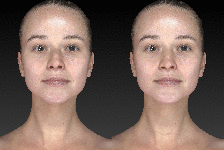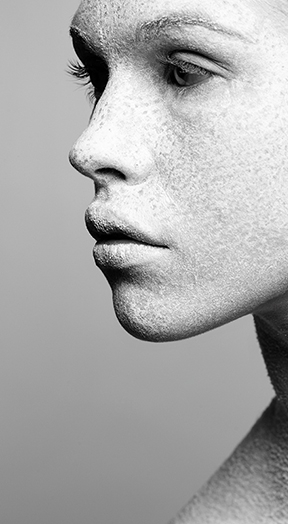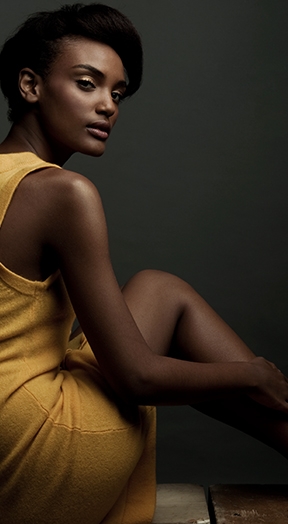A rhinoplasty, otherwise known as a “nose surgery,” is one of the most common cosmetic surgery procedures. The procedure offers a wide range of uses, as it can be used to alter the shape and appearance of the nasal bridge, nostrils, nasal tip, and columella. Bay Area Plastic Surgeon John R. Griffin performs rhinoplasty to improve the function and appearance of the nose.
Vectra 3d Imaging for Rhinoplasty
|
Vectra 3D imaging technology helps patients visualize their potential individual outcomes. During the rhinoplasty consultation, Dr. Griffin will take a 3D image of the patient. Once the image is displayed on his computer screen, Dr. Griffin will explain their current condition and explain their options and limitations by simulating their results on the image. |
Candidates
The best candidates for rhinoplasty are those over the age of 14. Until that point, the nose may still be growing, and the cartilage may not have reached its final form. Patients who undergo rhinoplasty may be unhappy with:
- A hump or bump on the ridge of the nose
- A wide, flat, narrow, or curved nasal bridge
- A bulbous, large, pinched, or curved nasal tip
- The nasolabial angle
- An overly prominent nose
Patients who wish to undergo rhinoplasty should be in good general health and abstain from the use of tobacco products. During the consultation, the doctor may ask about allergies that affect breathing or chronic use of nasal sprays. These may affect recovery from rhinoplasty.
Rhinoplasty and Insurance Coverage
Rhinoplasties are not covered under insurance. If a septoplasty is necessary for medical reasons, such as to correct nasal passages that inhibit breathing, the costs of this procedure may be covered by insurance. In these cases, Dr. Griffin and his staff will refer you to an ENT for the septoplasty procedure. Changing the appearance of the nose is not covered under insurance because it is considered a cosmetic/elective procedure.
Rhinoplasty Techniques
During surgery, Dr. Griffin will perform the rhinoplasty technique that is best suited to the patient’s nasal anatomy and cosmetic goals.
- Open rhinoplasty: In the open rhinoplasty technique, the incision is made across the outside tissue that separates the two nostrils (known as the columella).
- Scaffolding: In cases where areas of the nose may need to be built up, cartilage from another part of the body may be used. Dr. Griffin usually uses cartilage from the septum itself. Sometimes he uses cartilage from the ears or ribs.
Rhinoplasty Procedure Steps
The rhinoplasty procedure involves the following steps:
- A surgical pen is used to mark the treatment areas
- The anesthesiologist puts the patient under general anesthesia
- Antibacterial solution is applied to the nose
- The incisions are made along the columella or inside the nostrils
- The skin is lifted up off of the nasal structures, giving Dr. Griffin access to underlying bone and cartilage
- Cartilage is removed and reshaped along the bridge, tip, columella, septum, and nostrils to produce the desired aesthetic
- The skin is placed back over the nose and sutures are used to close any large incisions
- A splint is put in place to help the nose maintain its new shape
- Medical tape and/or bandages are applied to the nose
Rhinoplasty Recovery
Patients will be required to wear a nose splint for the first week following rhinoplasty. The splint holds the cartilage in place until it stabilizes, protects the nose in case of any accidental bumps, and prevents the formation of scar tissue.
Packing inside the nose may also be used, particularly if the procedure was performed to improve breathing. The nasal packing will be removed after four days to a week.
Straining, bending, or lifting heavy objects should be avoided for the first few weeks following surgery. Patients should also refrain from blowing the nose for a week after surgery. Most patients are able to return to work about two weeks after surgery. Exercise can be resumed about six weeks after surgery.
Rhinoplasty Side Effects
The most common side effects of rhinoplasty include pain, bruising, and swelling around the nose. This may last for a couple of weeks after surgery. There may also be increased nasal discharge.
Rhinoplasty Risks
Some of the risks of rhinoplasty include:
- Bleeding
- Injury to the septum (the inner structure that separates the nostrils)
- Irritation or skin problems from the surgical tape
- Infection
- Reaction to anesthesia
- Numbness or change in sensation at or near the incision sites
- Irregularities in skin contour
- Skin discoloration
- Nasal asymmetry and problems with cosmetic result
Patients should discuss these risks with Dr. Griffin, and contact him as soon as possible if complications occur.
Rhinoplasty Results
The rhinoplasty recovery process takes time as the cartilage, bone, and tissue are healing. However, initial results should be visible within the first weeks of surgery. Final results are typically seen six weeks to six months after. The results of rhinoplasty surgery can last a lifetime.
Rhinoplasty Consultations
To schedule a rhinoplasty consultation, contact Dr. John R. Griffin.








